
Day 5: Black Sea Silk Road Corridor: On the trail
Ararat Province, Pokr Vedi-Khor Virap & Vayots Dzor Province, Yeghegnadzor-Noravank & Syunik Province, Goris-Tatev
What is this road corridor for? Who invented? It existed since when?
When you search the Internet, you may find plenty of ancient trade routes from world history. Silk Road is one of them. It is one of the great trade routes like Spice trade, Tea route and Amber road. Black Sea corridor is also considered to be the passageway on Silk Road. Thus, Black Sea Silk Road Corridor is designed to revive one of the historical routes of the ancient world and put on project to retrace the western part of the Silk Road.
The purpose of the project is to recall the existence of wonderful sites, monuments, natural parks, archaeological sites, and cultural monuments, which are witnesses of the artistic wit of former generations. The start point of this regenerated trail is Thessaloniki, Greece. The trail visits Turkey and Georgia on its path, finally ending up at the southernmost city of Armenia, Meghri.
To get further information, you may visit the official website.
Back to topic, my daily plan consisted of 3 amazing Monasteries to explore. As I set my route from the previous night, I just needed to do my checkout from the hostel. Right after making a double check not to forget any personal belongings left in my room, I paid my dues and got on my car to carry out my plan.
Here is today’s route plan…

By 9am I was already out of Yerevan, driving to the south, on a highway with the exciting view of mount Ararat. The supreme mountains (Greater Ararat) with its little brother Masis (Lesser Ararat) located nearby have always been a conflict in between Turkey and Armenia. Both sides demanded those massive beauties very strongly because of their iconic value. The mountains changed sides for centuries in history. Finally, after the establishment of Republic of Turkey in 1923, the mountains were considered to reside in the Turkish territory as of agreed in the Treaty of Lausanne.
What is more, myths according to the book of Genesis claim that, Noah’s Arc visited the mountain to rest.
Geologically, the Ararat massif has a diameter about 40 kilometers as a whole. As the highest peak of Turkey, the Greater Ararat is 5,147 meters tall. Although the gloomy weather caused an unpleasant photo capture, the dignity of the mountains were unarguably out of bounds.
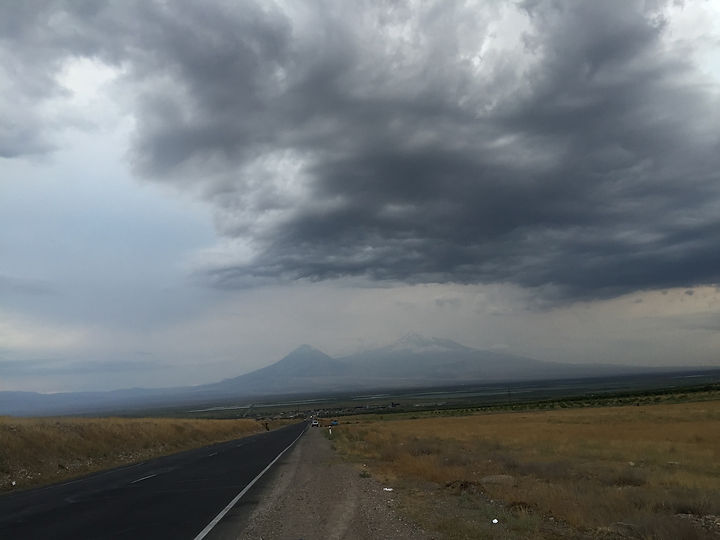
Mount Ararat
I was getting closer to the Khor Virap as I halted to take a panoramic picture of the monastery.

Khor Virap
Sticking to the plan, I arrived at my first destination, Khor Virap (St. Gevorg Church), residing in a village called Pokr-Vedi, only 100 meters far from the Turkish-Armenian border. Peculiarly, this time parking was for free. Instead, two young men, standing right beneath the stairs of the monastery, as they were the hosts, gave me a kind greeting. Then they offered me to let two pigeons that were in their fingers, identical like twins, as an entrance tradition of the site. Unhesitatingly, I accepted their offer without even asking the price. So, the man passed me the two identical conjoined pigeons to one of my hands, and watched me releasing them to the sky. Then, he offered me to repeat the freedom ceremony once more. Again, without asking how much it would cost me, I set another lovely couple free. As they explained, this was a historical ritual, repeated since the opening of the monastery (if you take it of course).
Then, as a matter of fact, as nothing is free in this world, they asked me to pay five thousand drams per flight, which makes ten thousand drams in total. Accepting my foolishness, I was not going to pay that much anyway. So, after a quick negotiation, they accepted to take 5,ooo drams (approximately 10 US Dollars).
By ascending the rocky steps, I entered the monastery territory and the first thing I’ve seen was the great side view of the Holy Mother of God Church (Surp Astvatzatzin).

Surp Astvatzatsin
St. Astvatzatzin church is unique in that instead of the domed cruciform with four corner annexes typical for medieval Armenian churches, the structure has a domed long hall with two annexes, one on either side of the apse. The hall is divided by a central arch, which forms the western side of the square that supports the 8-faceted drum. On its outside, the building appears to be a typical domed cruciform, the rooflines forming the wings of the cross.
The other building in the territory is the St. Gevorg Chapel. It is a small basilica replete with a semicircular apse. Inside the chapel, exist two deep pits. Grigor's is the farther one, 6 meters deep. The pit is approached through two unmarked holes. A small chamber, winding stairway, and a ladder lead to a small enclosure in the pit. To the right of the altar in the dungeon is the main room. The notability of the chapel is attributed to the fact that the Armenian King Tiridates III kept Grigor Lusavorich prisoned in a cell for 14 years. Subsequently, Saint Grigory became the king’s religious mentor and later became Saint Gregory The Illuminator. Unlike Armenian churches that have an East-West orientation with the altar at the east end, St. Gevorg Chapel was oriented Northwest-Southeast.
An interior view from the Chapel…

St. Gevorg Chapel
Just because I am not comfortable with narrow and tight places with unpredictable endings, I couldn’t descent to see the prison cell.
Instead I’m attaching an overhead view of the pit’s underground entrance from a safe ground…

Khor Virap Pit
Having investigated enough of Khor Virap, I had left the monastery and drove off to my next checkpoint, Noravank Monastery. On my way, I bypassed the settlements Ararat, Surenavan, Paruyr Sevak, Tigranashen, Zangakatun, Yelpin, Chiva and a popular wine village, Areni. A kilometer past Areni village, there I saw the road sign directing the monastery. The road was apparently called Noravank monastery road.
As I am a fan of roads cutting through valleys and mountains, I stopped the engine, got out of the car with my camera, and by releasing my shutter I saved that memorable moment forever.

It was almost noon when I got to the monastery. I realized that I needed a coffee break before I visited Noravank. There stood a vending machine right near the entrance of the monastery, so I approached by and selected a high caffeine low sugar cappuccino. Having a cup of coffee, I regained my power back and headed to the church. The complex was surrounded by the fortress walls, which were built in late 17th century, while the monastery itself, was founded in 1205 by Bishop Hovhannes.
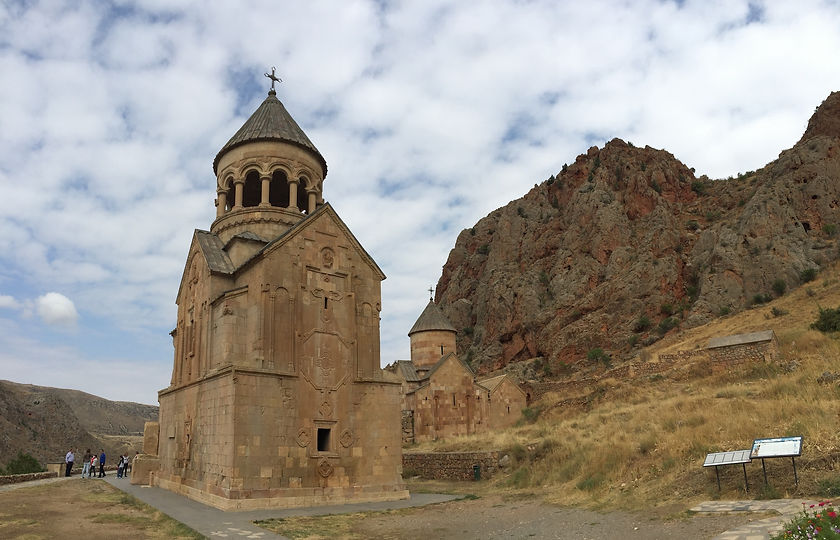
Noravank Monastery
The monastery is best known for its two-storey St. Astvatzatzin (meaning Holy Mother of God) Church, which grants access to the second floor by way of narrow stones jutting out from the face of building.
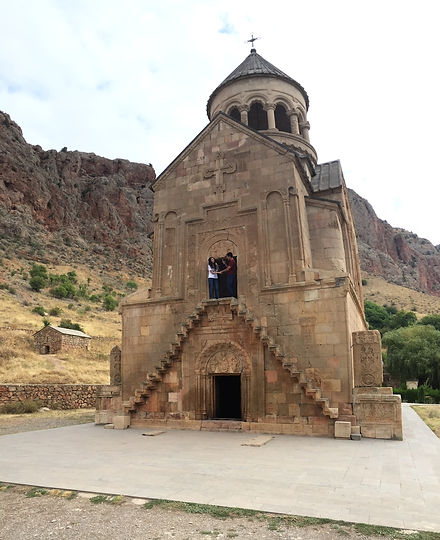
Surp Astvatzatzin
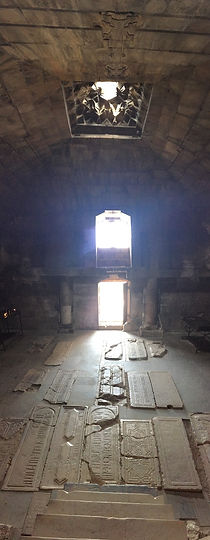
Inside the church, carved tablets and carved tombstones were laid right on the ground floor.
Other notable structures of the monastery complex are Surp Karapet church and Surp Grigor chapel. Surp Karapet church hosts a precious mausoleum of Prince Smbat Orbelian's, while Surp Grigor chapel contains Orbelian family tombs, including a splendid carved lion/human tombstone dated 1300, covering the grave of Elikum son of Prince Tarsayich Orbelian.

Besides those, the territory hosts several Khachkars(Armenian Cross-Stone). Moreover, gorgeous ornaments, carvings and decorations on the structures of the complex drew my strong attention. If you are also interested, see the page of various ornaments and decoration of Noravank Monastery.

Noravank Monastery Khatchkars
My tour at the monastery complex took approximately an hour. I identified a suitable spot to take a last panoramic look to the nature around, stood there for a couple of seconds, saved the view in my memory and continued.
Next stop, Tatev Monastery was almost a three-hour drive far. I was on the roads again passing from one province to another, this time fromVayots Dzor province to Syunik province.
To get to the Monastery complex, there is a ropeway from Halidzor settlement to Tatev. The record-breaking ropeway was called ‘Wings of Tatev’. This non-stop, double aerial tramway is the longest reversible cableway recorded in the book of Guinness Book of Records, with its 5,752m long span. As of October 2015, Wings of Tatev celebrated its 5th anniversary.
The ride from Halidzor station to Tatev station takes twelve minutes. Hanging on the air, in a full glazed cabin, makes you feel like a free bird swinging underneath the clouds.
Approaching Tatev, the foggy view of the Monastery from far distance was outstanding.

Tatev Monastery
Once I stepped out of the cabin and got nearer to the monastery, the closer I got, the more remarkable it became. My first glimpse of the monastery was enough to make me feel exited.

Tatev Monastery
Before visiting the church, I would like to tell you a legendary story of this monastery. The legend asserts that, when the master finished his work in Tatev Monastery he came to the very edge of the cliff, crossed himself saying “Ognir Surb ta tev” translated as “Let the Holy Spirit give me the wings” and abruptly threw himself down. According to mystic legend, suddenly two wings grew on his back and he flew away. Subsequently, the monastery was named Tatev in honor of the master whose appeal was heard by God.
The fortified monastery, belonging to Armenian Apostolic Church, founded in 4th century, consists of three churches named Saints Paul and Peter, St. Gregory the Illuminator and St. Mary respectively. Here also exists a library, dining hall, belfry, mausoleum, monument as well as other administrative and auxiliary buildings.
The Saints Paul and Peter church is referred to the Church of the Apostles as it was dedicated to the two apostles of Christ. Saints Paul and Peter church is the oldest remaining structure within the Monastery complex. It was built with the initiative of Bishop Hovhannes and the financial assistance of reigning Prince Ashot, his wife Princess Shushan and Princes Grigor Supan and Dzagik. The church was built between 895 and 906. An arched hall was added adjacent to the southern wall of the Saints Paul and Peter in 1043.
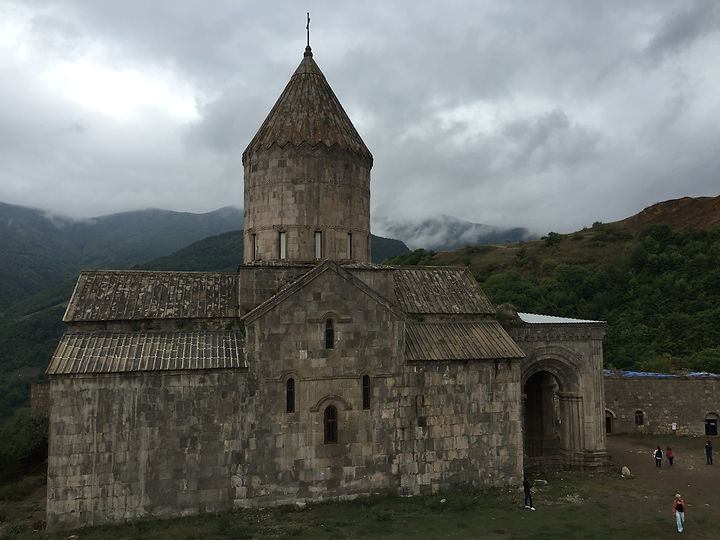
Sts. Paul and Peter Church

Sts. Paul and Peter Church lectern

Sts. Paul and Peter Church dome
The St. Gregory the Illuminator Church is adjacent to the southern wall of the Saints Paul and Peter Cathedral. The church was first built between 836-848 with the order and financial support of Prince Philipé of Syunik.
The church of St. Gregory has a very simple structure. It does not have a dome. It has three support pillars in its northern and southern walls that bear the arches upon which the inclined roof tiles are installed. Its entrance is decorated with fine geometric carvings. The church was used as a funeral chapel.

St. Gregory the Illuminator Church
St. Mary’s Church is located along the northern fortifications of the monastic complex. It was built in 1087 as a second storey to the covered mausoleum near the entrance.

St. Mary’s Church
The pendulous column (called Gavazan Siun) is a monument dedicated to the Holy Trinity. The column is about eight meters tall and is crowned with a khachkar. It has few decorations and no inscriptions and has been left unaltered since its construction. The column was functioning as a Seismographic-balancing pillar. Thus, the key purpose of the column is to alert of minor earth tremors and thus giving early warning signals about possible earthquakes. The column returns to its vertical position after it moves.

Gavazan Siun
The pendulous column (called Gavazan Siun) is a monument dedicated to the Holy Trinity. The column is about eight meters tall and is crowned with a khachkar. It has few decorations and no inscriptions and has been left unaltered since its construction. The column was functioning as a Seismographic-balancing pillar. Thus, the key purpose of the column is to alert of minor earth tremors and thus giving early warning signals about possible earthquakes. The column returns to its vertical position after it moves.

A view from a Monk cell
What is more about the complex, the Monastery hosted a university that operated between 1390 and 1434, where instructors were educated and trained not only for the province of Syunik, but also for other regions of Armenia. Also, in his History of the Province of Syunik, Stepanos Orbelian describes how the monastery served as the repository for thousands of valuable manuscripts, monastic and official documents and contracts.
For an impressive 3D virtual narration including legendary stories of Tatev Monastery, see the link.

Tatev aerial tramway station
Finishing my tour around the complex, leaving the tranquility of the complex to itself, I took the same ropeway back to Halidzor station, where all the adventure began. I’ve stationed myself on the wheel once again, buckled up and drove off the station. It was getting darker when I was heading to Goris. The black-stoned fortress shaped gate welcomed me. The tremendous gate was literally guarding the whole city.

Goris gate
Before settling down to my hotel, as I was starving, I needed a decent place to dine out. Driving downtown, I noticed a restaurant-hotel complex. I thought it was worth trying.
When, I entered the restaurant, I found myself wondering where I was. Apparently, I found myself in the middle of a feast. As I was not in suits or in a formal dress, everyone turned their heads towards me, and started gazing at me like I was coming from another planet. The waitress showed me a separate private room, instead of inviting me amongst the crowd in the main ballroom. I ordered some veal on barbeque, matzun (Armenian strained yoghurt) as usually, and some fresh salad.
While waiting my orders, I brought out my maps from my handbag, and started making route plans for the following days. Besides creating my routes, I had to consider the cities I was going to stay for the night. Searching the web for accommodation options, I found cute boutique hotels with family atmosphere. On the other hand, in the restaurant, loud music covered all over the place as right next door there was an entertainment going on. By then, my dishes arrived. The meat was so fresh as it was a product of a small farm village. Enjoyed my meal, paid the bill and exited.
Goris was a conservative, small village city. So, it didn’t take so much time until I found my hotel. It was located on a hill overlooking the city.

Goris overlook
The place was called Yegevnut Hotel. My first impressions were positive. Hotel staff was so friendly and hospitable. The owner himself accompanied me to my room. I immediately undressed and rushed to the bathroom to take a warm relaxing shower to get over my exhaustion. I felt much better though. I lied down on my twin bed and after a while I was asleep. I only remember opening my eyes early in the morning next day.
